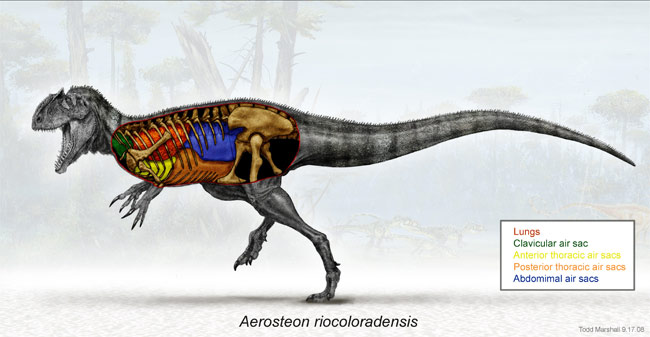The dinosaur is as big as a bird-like respiratory bus
A huge carnivorous dinosaur that lived 85 million years ago has a respiratory system very similar to today's birds, according to an archaeological analysis revealed, this has reinforced the evolutionary link between dinosaurs and Modern birds.
The findings shed light on the transition between theropods (two-legged carnivorous dinosaurs) and birds. Scientists think that birds evolved from a theropod group called maniraptor (which lived about 150 million years ago in the Jurassic period), an evolution that lasted between 206 and 144 million years ago.
Researcher Jeffrey Wilson, a paleontologist at the University of Michigan, said: 'This is another evidence that adds to the list of evidence linking birds to dinosaurs.'
Strange dinosaur species
Aerosteon riocoloradensis bipedal dinosaurs are as high as 8 feet (2.5m) from the hips, with a body length of about 30 fut (9m) equivalent to a bus length.
Wilson, along with University of Chicago paleontologist Paul Sereno, and several other scientists discovered the skeleton remains of A. riocoloradensis during an expedition to Argentina in 1996. In the following years The scientist cleaned the skeleton and then scanned with X-rays.
The results showed that there were some small holes in the spine, clavicle (chest bone that made up the clavicle) and hip bones that led to the formation of large gaps. When the dinosaur is alive, these gaps are lined with air-soft tissues. They are similar to the traits found in modern birds as well as such bones.

Illustration Aerosteon dinosaur hunting with red lungs and air bags (many other colors) when they were alive 85 million years ago.(Photo by Todd Marshall c 2008, courtesy of Project Exploration)
While there is no evidence that dinosaurs have a feather on their bodies or fly like birds when they are alive, the findings suggest they breathe like birds.
Modern birds have inflexible lungs, they do not open and contract like our lungs. Instead, the airbag system is responsible for blowing air through the lungs. This strange feature is the reason why birds fly higher and faster than bats. Like all mammals, the lung elasticity should have a less effective respiratory process.
Other air sacs of birds lie in the spine. It is thought that they make the bird's bones lighter so they fly more easily.
Wilson told LiveScience: 'We are beginning to learn more about the evolution of specialized respiratory systems in birds by tracking their ancient relatives. Interestingly, these ancient relatives are not like birds. '
Reduce the payload
Wilson and his colleagues suggest that hollow bones and air sacs may have many different purposes, such as helping dinosaurs to breathe more effectively.
According to Wilson, weighing an elephant Aerosteon can also use holes to release unwanted heat inside the body.

In 1996 news spread quickly about the discovery of the first new dinosaur in Mendoza province (Argentina).On the photo the excavation team is pointing piles of bones for visitors.(Photo: David Varricchio c 2008, courtesy of Project Exploration)
Another benefit of having a lot of gas is probably to reduce weight.'A mild but healthy spine can hold an important function. When we have a large body, weight is also an important issue. '
Some dinosaur fossils also have many bird-like characteristics, although no discovered carnivorous dinosaurs carry evidence of air sacs in the clavicle.
For example, past studies show that maniraptor dinosaurs, such as velicoraptor or tyrannosaur, for example, are equipped with structures that move the ribs and sternum during respiration in birds.
Scientists also discovered air sacs in the spine of sauropods, a group of long-tailed and long-tailed dinosaurs that lived in the late Triassic and Jurassic period 180 million years ago.
The findings are published online in detail in PloS ONE.
- Distinguish between regular flu and bird flu
- Discover the most mysterious, ancient and mysterious
- Discover the smallest dinosaur footprint ever
- 10 strange extinct animals
- Bird flu can cause intestinal illness
- Meat-eating dinosaurs acted like bird's nest
- Detect bird's bones in dinosaur belly
- Discover the most bird-like fossil flying dinosaurs
- The oldest feathers of dinosaurs appear on rocks
- Shocking discovery of dinosaurs drive and
- Scientists recreate dinosaur embryos from chicken DNA
- Detecting the nocturnal egg nest of the dinosaur fetus
 Discovered an ancient centipede fossil 99 million years old
Discovered an ancient centipede fossil 99 million years old Discovered bat-like dinosaurs in China
Discovered bat-like dinosaurs in China Discovered a 200-year-old bronze cannon of the coast
Discovered a 200-year-old bronze cannon of the coast Discover 305 million-year-old spider fossils
Discover 305 million-year-old spider fossils